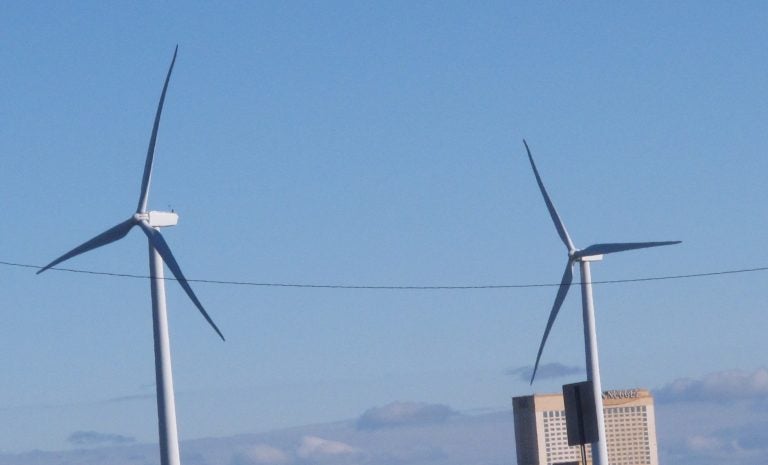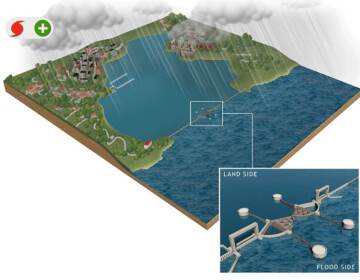Which N.J. ports could be offshore-wind industry hubs? Edge for Paulsboro?
N.J is beginning to inventory its port facilities across which could function as hubs for economic growth as part of Murphy’s agenda to create a robust offshore-wind industry.

Windmills at a sewer plant in Atlantic City, N.J., turn in the wind on Monday Jan. 4, 2016. The Environment New Jersey environmental group issued a report Monday saying that New Jersey has the greatest potential to develop offshore wind energy of any mid-Atlantic or New England state. (Wayne Parry/AP Photo)
The state is beginning to inventory port facilities across New Jersey that could function as hubs for economic growth as part of the Murphy administration’s ambitious agenda to create a robust offshore-wind industry.
The emerging inventory has identified 38 facilities that might serve as suitable places to build out ports targeted for providing places to manufacture, stage and assemble the wind turbines, foundations, towers and other components necessary to grow an offshore-wind sector.
The identifying of potential port sites is being duplicated up and down the Eastern Seaboard as states vie for the potential jobs and a share of the projected $100 billion investment in an emerging industry that could see up to 10,000 megawatts of wind capacity developed offshore by 2030.
“There’s competition around the ports because they are going to be the hub of economic activity,’’ said William O’Hearn, communications director for the Business Network for Offshore Wind.
The list of potential sites was developed by the New Jersey Board of Public Utilities as part of an ongoing stakeholder process, primarily designed to determine the logistics and other factors that ought to be considered in developing ports to serve offshore-wind farms.
Key decision in early summer
The BPU is expected early this summer to decide on what developers will build the state’s first offshore-wind farms. Three developers have submitted applications to build up to 1,100 MW of wind capacity off the Jersey coast, but the agency has refused to make the applications public, citing proprietary information submitted by the developers. The BPU declined to comment for this article.
Ørsted North America, a Danish developer, is proposing a project 15 miles off Atlantic City. EDF Renewables/Shell New Energies, a French company, is seeking approval to build turbines eight miles north. Equinor, a Norwegian company, is pushing a project 20 miles off the coast of Monmouth County.
By 2030, New Jersey hopes to build at least 3,500 MW of offshore-wind capacity. New York recently set a goal of 9,000 MW by 2035. From North Carolina to Massachusetts, other states have committed to build offshore-wind farms, hoping to cash in on the jobs and investments the sector could bring.
“There are definitely opportunities for everyone to move out ahead in this area,’’ said Doug Copeland, development manager for Atlantic Shores, the project by EDF Renewables, one of the three developers competing to build a wind farm off the Jersey coast.
No single port on the East Coast is capable of hosting all aspects of the offshore-wind sector, Copeland noted.
Major state investment
Because of the huge scale of the wind farms and the gigantic turbines that will produce electricity, the state may need to invest huge dollars in upgrading existing ports to handle the assembly and shipping of turbines and other equipment.
At a conference on offshore-wind last fall, Julie Bovey, representing Equinor, said it looked at one port for potential use in its project and found it needed $350 million in upgrades; another was only slightly better, requiring $100 million.
The sheer size of the wind turbines brings other challenges; the huge turbines are expected to be shipped offshore upright, making it easier to assemble them offshore. That would preclude using ports that necessitate having to ferry the turbines under the Verrazzano-Narrows Bridge or the Delaware Memorial Bridge because the turbines would be too tall to make it through.
More than $200 million already has been invested to upgrade the port of Paulsboro, a decision that has made it one of the likely choices to host some offshore-wind segments, advocates say.
“Paulsboro is one of the small handful of sites ready for the offshore wind industry despite the air draft issue,” said Brian Sabina, senior vice president for economic transformation for the New Jersey Economic Development Authority. (The “air draft issue” refers to the inability of the turbines, when vertical, to clear under bridges or high-power transmission lines.)
‘…multiple ports required’
It remains the frontrunner as a potential location for offshore-wind manufacturing because of those investments, said Doug O’Malley, director of Environment New Jersey, who is part of the stakeholder process. “There’s going to be multiple ports required; hopefully the majority will be in New Jersey,’’ he said.
Boosting those prospects, the state EDA has begun accepting applications for up to $100 million in tax credits to build offshore manufacturing facilities to developers who create at least 300 new full-time jobs. Sabina declined to say if the agency has received any applications from the offshore-wind developers.
Other ports in New Jersey would require major upgrades, Sabina said. A strategic offshore-wind plan under development by the state is expected to provide high-level estimates of those costs, he added.
Besides Paulsboro, those involved in the process say a location in South Amboy, a brownfield site where a small power plant once operated, has drawn interest from developers. It does not have the air draft issues associated with other locations, according to Sabina.
Potential locations also include the Naval Weapons Station Earle, Oyster Creek, parcels owned by the Port Authority of New York and New Jersey, and numerous other sites up and down the coastline.
“The inventory of New Jersey ports is pretty well understood,’’ O’Hearn said.
WHYY is your source for fact-based, in-depth journalism and information. As a nonprofit organization, we rely on financial support from readers like you. Please give today.




